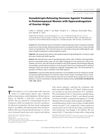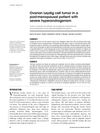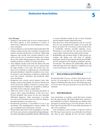TLDR A postmenopausal woman had high testosterone from her right adrenal gland, leading to recommended surgery.
Severe virilization in postmenopausal women was a rare occurrence in clinical practice. This case report described a postmenopausal woman who experienced significant hirsutism and androgenetic alopecia. Diagnostic imaging ruled out a malignant tumor as the cause of her hyperandrogenism. Further investigation through selective venous sampling revealed elevated testosterone levels in the right adrenal vein, suggesting an adrenal origin. As a therapeutic measure, a right adrenalectomy and prophylactic oophorectomy were recommended to the patient.
 36 citations
,
May 2011 in “The Journal of Clinical Endocrinology & Metabolism”
36 citations
,
May 2011 in “The Journal of Clinical Endocrinology & Metabolism” Treatment with a hormone agonist can reduce excess male hormones in postmenopausal women without surgery.
 22 citations
,
February 2014 in “Arquivos Brasileiros De Endocrinologia E Metabologia”
22 citations
,
February 2014 in “Arquivos Brasileiros De Endocrinologia E Metabologia” An 81-year-old woman's severe male hormone symptoms were caused by an ovarian tumor, which was treated with surgery.
 31 citations
,
May 2012 in “European Journal of Dermatology”
31 citations
,
May 2012 in “European Journal of Dermatology” Menopause affects hair and skin; more research needed for treatment.
 67 citations
,
September 2008 in “Dermatologic therapy”
67 citations
,
September 2008 in “Dermatologic therapy” Hirsutism is excessive hair growth in women often caused by polycystic ovarian syndrome, and identifying the cause is important for managing associated health risks.
 January 2019 in “Springer eBooks”
January 2019 in “Springer eBooks” Acne can appear or persist in adulthood due to hormonal changes, external factors, or substance use, and requires appropriate treatment.




